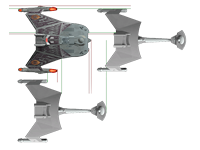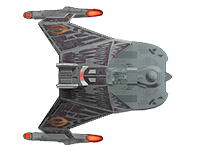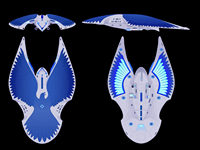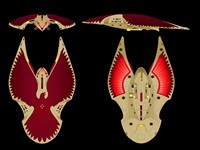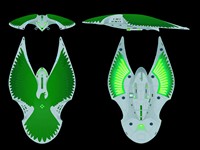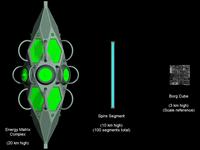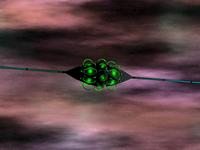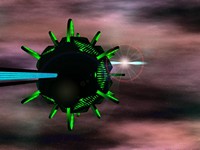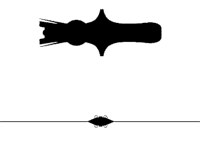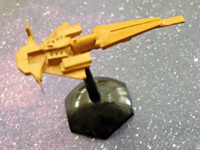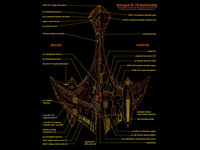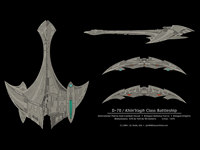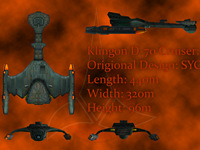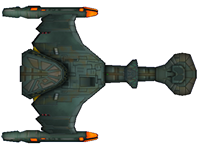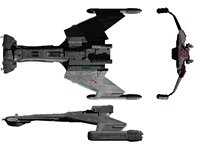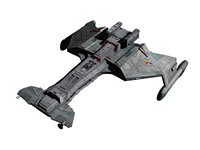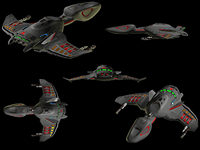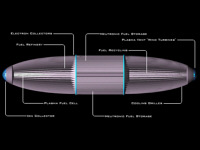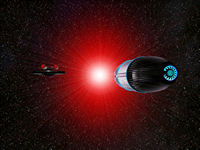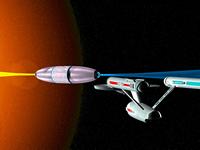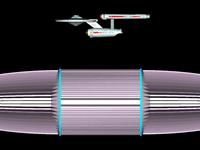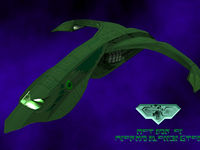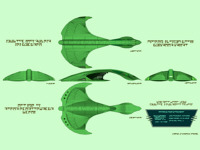Alien Designs
Other Designs, Alien Starships, Future Starships & Design Studies, Abramsverse Designs
Bajoran Battlecruiser 
Design by Syckoson
Affiliation: Bajoran
Type: Light cruiser
First commissioned: 2377
Length: 200m
Width: 180m
Height: 66m
The Bajorans did well financially after the Dominion War. They became a trading hub between the Alpha and Gamma quadrants. This meant they had to protect their assets. They were working on a peace and eventually trade treaty with Cardassia but in the mean time they struck a deal with the Klingons and Ferengi to procure old D7 class ships and heavily armored freighter hulls modified to act as a light cruiser. Now the most aggressive and dangerous ship in their fleet the pirates and other groups had to take them seriously.
Using D7 Mk 3 hulls. Sections from k24 that were not needed after being upcycled and a custom bridge and fore section by the Ferengi. The warp nacelles and nacelle mounted weapons were upgraded to those used on the Klingon battle barge and K24 respectively. While no match for a Vor'cha or Negh'var on its own, in a pack these can be extremely dangerous. Packing modern weapons on an agile and tried and tested platform they are likely the most powerful D7 variation to date. Two of these would easily overwhelm a Galor or Keldon, and they are always found in packs. Like the Bajoran Hara Cat they are fast, graceful and deadly.
Thanks to Atolm for the warp Nacelles and Paramount/CBS for the cool D7 and Merchantman designs.
Bird of Prey Class
Design by Phil Sherman
Affiliation: Romulan/Schrike
Type: Medium battleship
First commissioned: 2399
Length: 206m
Width: 138m
Height: 38m
Decks: 7
Displacement: 195,000t
Complement: 20 officers + 100 crew, evacuation limit: 275
Speed: Warp 8 (cruise), Warp 8.6 (max.), Warp 9 (max. emergency)
Sublight speed: 0.9c (max.)
Armament: 2 Romulan disruptors, 2 enhanced long range Romulan disruptors, 3 Type XII phaser arrays or equivalent technologies (added during the Schrike refit), 1 enhanced prototype Romulan plasma torpedo launcher and 2 Federation photon torpedo launchers, added during the Schrike refit (quantum torpedo capable)
Defense: New experimental cloaking system (this system uses so little power that the BoP can remain cloaked while firing all weapons but the plasma torpedo.), Metaphasic Shielding System (added in the Schrike refit, replacing the standard shields) and 20 mm Romulan experimental enhanced ablative armor. Properties of the armor seem to dissipate energy at an astounding, and as of yet, undeterminable rate. Elemental structure of the armor is complex and multi layered. The armor is being studied by Federation research and development scientists.
Embarked craft: 2 Romulan shuttle pods, (4 crewmembers max/ea), two full size type six federation shuttles and one work bee.
On Stardate 2399 a distress call was received by the USS Crazy Horse on patrol at the edge of the Neutral Zone. A Romulan D'deridex-class Warbird was under attack by an unknown starship. Badly disabled, and losing containment, the Warbird was desperately calling for help. The Crazy Horse immediately hailed the attacking ship, but got no response. The Crazy Horse arrived too late to help the Warbird, and the alien vessel had already vanished, a thorough investigation was carried out until the Romulans arrived, at which time the Crazy Horse returned to Federation space. Amounts of non-Romulan debris were minute, indicating some sort of Cloaking Technologies must have been used to cover the escape of the craft. The USS Crazy Horse conducted continued hails and scans of the surrounding space until it arrived on the scene, shortly after the Romulan Warbird had been destroyed. The Federation was contacted by the Vulcan High Counsel two days later, bringing more information to light.
The Schrike, a large group of Romulan revolutionists had owned up to responsibility for the incident, but stressed the Romulans attacked first. The Schrike wanted to start talks with the Federation in order to establish themselves as more than a rogue rebellion. The Schrike consider themselves patriots, and want Romulus free from its current oppressive political structure. They are tired of trying to do this from within, so they basically formed their own government, and are going to try the more direct approach of a Civil War. They needed the Federation to recognise them in order to promote alliances with sympathetic races. The Schrike have a small fleet of Romulan Birds of Prey. They have re-fitted the ships with Federation technology, as Romulan support is getting harder and harder to procure. The Birds of Prey fell into Schrike hands when they learned of a secret operation, where the Romulans were trying to build a fleet of new, very powerful, smaller ships. Infiltrating this secret shipyard was not hard, but coordinating the attacks on other systems, to try to remove all record of the ship, science facility, and shipyard, as well as the assassination of key figures, was very difficult and took 6 months to carry out. It appears they succeeded. The Schrike decided to change the ships color scheme as well, so they would not be mistaken by allies, and to promote unity in their cause.
In 2400, the Federation ushered in the new century with the Tulache Accord. A Federation/Schrike treaty, which established full trade and technology sharing between the Schrike and all Federation outposts and territories. Relations between Romulus and the Federation have been strained since, but as long as the Federation doesn't stand against Romulus with the Schrike in their 'war', Romulus will keep peaceful negotiations with the Federation. After the treaty was signed, the Federation received a complete download of the tech that went into creating the Bird of Prey, and found out the reason why it was so devastating. The main weapon of the Bird of Prey turns out to be its cloaking emitter. The technology of the cloaking device itself, and the emitter, allows the Bird of Prey to fire while cloaked. When firing, the BoP appears to de cloak for 5 seconds, then re cloak, but the truth is that the cloak is engaged the whole time, but the weapons interfere with the cloak, with energy transference, when they fire, dissipating over a few seconds, thus allowing the cloak to re stealth the ship. This compiled with the newly installed metaphasic shields and experimental Romulan ablative armor, make the ship extremely durable.
After receiving the information, they immediately amended the treaty, making the Schrike equip all of their ships with new transponders, designed to be connected directly to the BoP's quantum singularity warp core, and thereby not easily able to be turned off. The Schrike agreed, but wanted assurance that the Romulan Empire would not be able to track the signal. A new type of carrier wave was used for the transponders, that emulates normal radiation in space, and can only be determined as a carrier signal for the transponder by using the correct 250 alpha numeric key sequence code in the transponder encryption software. The Vulcans graciously donated a small portion of their space near the Neutral Zone for the Schrike to settle in. The Schrike have chosen a small planet in the middle of a dense nebula within that space to call home. The name of the Schrike planet has been designated Schrican, a combination of Schrike and Vulcan, in honor of their Vulcan benefactors. In Honor of the Tulache Accord, the Schrike took one of their last BoPs, and completely retrofitted it with Federation tech, LCARS panels and computers, a Federation warp drive, Federation Colors, everything. The only thing Romulan left on the ship was the cloaking system, even the disruptors were switched out for phaser pulse cannons. It was a monumental task, and took nearly 8 months to complete. Once finished, the Schrike donated the ship, christened the "Achilles", to Starfleet. The Federation was not allowed to develop or build cloaking systems for close to 300 years, but they now find themselves with a fully functional cloaking vessel, without a treaty violation.
Borg Energy Spire
Design by Robert Heckadon
Affiliation: Borg
Type: Power station
Length: 9,500m
Width: 9,967m
Height: 1,003,020m
Armament: 5 Borg tactical cubes
Defense: Regenerative ablative armour
"I am the beginning. The end. The one who is many." - The Borg Queen
Pulsars, the remnants of dead stars. Spinning many times per second with an unbelievably dense magnetic field emitting electromagnetic radiation from its poles in the form of radio waves. Megatron, a pulsar deep within the heart of the delta quadrant. And orbiting Megatron, feeding off the pulsar like piranha in the ocean of space, the Borg energy spire.
The Borg energy spire uses a 1000km long segmented spire to collect the electromagnetic energy from the pulsar Megatron. As Megatron spins at 33 times a second, its intense magnetic field "cuts" through the spire converting an extremely small amount of the pulsar's kinetic energy into virtually unimaginable amounts of isolytic energy. At the centre of the spire is a 20km high, 10km across energy matrix where the isolitic energy is refined and transmitted to the Borg fleet and worlds. The isolytic energy is transmitted using 6 interplexing beacons, subspace transmitters whose principles parallels those of the Borg's transwarp conduits, and broadcasts the energy to Borg ships all throughout the galaxy without the need for line of sight transmission.
The basic principle of the energy spire is similar to an old style solar drive known as an electrodynamic tether drive that was used during the time when star cruisers use to burn fuel in bulk. These included such ships as the Ares 4, the Botany Bay, and the ESS Charybdis. When an electric current, provided by solar energy, was conducted through the tether, it generated a magnetic field that caused Earth's magnetic field to propel the ship away from the planet. But when un-powered, the tether "cuts" through the Earth's magnetic field generating electrical current.
The spire and tether drive differ is when the tether generates electrical energy, the energy source comes from the kinetic energy or the speed of the orbiting ship. This then causes the ship to lose speed when generating power by this method. However with the Borg spire, the kinetic energy source comes from Megatron itself. Since its revolutionary rate is substantially greater than the orbital rate of the spire, then there is no worry about the spire's orbit decaying.
Many theorist believe that the Borg had assimilated the spire from an ancient alien species now extinct. It is also believed that the Borg's transwarp hub in the Delta quadrant, a collapsed star whose unique gravitational forces are "imploded" with regenerative exotic matter to create wormholes, was a key factor in transmitting the isolytic energy from the spire to the ships. And when it was collapsed by the U.S.S. Voyager, the Borg's primary energy source was cut off. Only time will tell if this is so.
References:
http://en.wikipedia.org/wiki/Electrodynamic_tether
http://www.daviddarling.info/encyclopedia/S/space_tether.html
http://www.tethers.com/EDTethers.html
http://www.jb.man.ac.uk/~pulsar/Education/Sounds/sounds.html
http://imagine.gsfc.nasa.gov/docs/science/know_l1/pulsars.html
Cardassian Lelaug Class 
Design by Aaron Hamilton
Affiliation: Cardassian
Type: Cruiser
First commissioned: 2240
Length: 229m
Displacement: 63100t
Armament: Phasers, spatial torpedos
These ships were used in advanced close-formation tactics to coordinate firepower vs individually stronger opponents. Squadrons of this type suppressed Klingon incursions, defeated Degrar battle fleets in two major wars in 2246 and 2261, and wiped out the armed Orion colony at N'rutoka in 2258. The design dispensed with easily-jettisonable nacelles to expedite production of ships.
Background: The Cardassians have been established as a rival to the Federation, Klingons, and Romulans, so I wanted to show how their ships developed before their first war with the Federation (pre-TNG). The Cardassian technology seems a step behind the Federation's and so they relied on tightly controlled formations of cruisers like these. This TOS-era ship, probably ranking in power between a Klingon D4 cruiser (FASA version) and D16 destroyer, has exposed deflector generators and nacelles embedded in the forward hull. It is called the Lelaug class. I add an extra enemy for the historic Cardassians to overcome in the Degrar, a species distantly related to the Anticans that had a coreward empire peaking in strength in the 1920s-2050s but broken up by 2310, Earth CE years.
More custom miniatures ships.
D-70 / Khin'Vagh Class
Design by Jeff Robb
Affiliation: Klingon
Type: Battleship
First commissioned: 2369
Length: 570m
Width: 434m
Height: 94m
Complement: 127 officers + 1248 crew
Speed: Warp 8 (cruise), Warp 9.6 (max.), Warp 9.9 (max. emergency)
Armament: 6 KD-27v1 and 10 KD-33v1 pulse disruptors, 3 KP-21v2 and 4 KP-22v4 photon torpedo launchers
Defense: KSV-3v1 redundant tactical shields
Embarked craft: 16 shuttlecraft
Background
The D-70 is a conjectural design that could exist in an alternate timeline wherein 24th-century Klingon technology is considerably more advanced than has been otherwise portrayed. In this timeline, factors such as a greater impetus for research, successful breakthroughs, and/or acquisition of alternate technologies would change the course of history enough to enable ships like the D-70. It is meant to be the representative starship of the Klingons, as the Galaxy-class cruiser is for Starfleet and the Warbird is for the Romulans. With the D-70 / Khin'Vagh in service, it is likely that ships such as the Vor'Cha and Negh'Var would not exist, since Klingon shipbuilding would be using different resources and techniques. As a point of comparison, a D-70 is intended to be superior to a Vor'Cha, and faster than but not as powerful as a Negh'Var. It would also be a general match for Starfleet's Akira-class tactical cruiser.
Technical Analysis
As its designation implies, the D-70 / Khin'Vagh is intended to possess ten times the potential of its direct ancestor, the D-7 / K't'inga-class battlecruiser. It also represents the state of the art in Klingon shipbuilding technology of the mid-24th century, and is thus intended to become the premier flagship across the empire. Specifically, it will fulfill primary roles of sector control, initial assault, and exploratory vanguard. Though more capable than any of its predecessors in operating effectively alone, it is expected to be found operating with at least one other Klingon ship, and most probably in the typical patrol trio. Modern Klingon production capacity enables this class to be as numerous as the D-7.
Physically, the D-70 strikes a dramatic silhouette, one that is both obvious in identity and purposefully crafted to appear dangerous. This unusual amount of esthetic engineering indicates the attainment of a high level of sophistication, one that allows such forms while also satisfying underlying functional requirements. The ship follows the established overall hull configuration for Klingon warships, with a forward command module connected to a wide main hull by a long "boom"; however, the decks within the main hull conform to its arc, an unusual but easily feasible characteristic. Distinctly pointed, curved, and beveled edges across the ship combine to form a strong resemblance to traditional Klingon bladed weapons. Even the warp nacelles, usually a strictly mechanical component, have also been purposefully styled to match the hull. Appropriately, the class name Khin'Vagh refers to a spearhead of multiple points; furthermore, from above, the whole ship also provides a remarkable resemblance to the three-pointed Klingon emblem itself, leaving no doubt as to this ship's origin and mission. It has even been speculated that the D-70's pointed "wing" tips have been specially reinforced in order to cut through the hulls of enemy craft. Although this unorthodox tactic has not been reported, it appears at least technically possible.
Like many large Klingon warships, the D-70's forward command module is separable and capable of sublight maneuvers, although useful occasions for its separation are rare. The large main hull remains capable of independent operation without the command module. A specialized sensor module is usually attached along the aft dorsal centerline. Surprisingly, the D-70 is not equipped with a cloaking device; this may represent a turn in Klingon strategy, wherein a powerful warship crewed by confident warriors need no longer hide themselves. If true, this fits more in character with traditional Klingon concepts of the honorable warrior, with the benefit of intimidating those who detect the battleship's approach. At any rate, it may simply stem from a preference to retain conventional shielding and firepower at all times. Instead of the cloaking device, the D-70 is equipped with versatile and powerful built-in arrays of Class-10 active ECM interference generators typically activated just beyond visual range. By jamming the sensor and comm arrays of its target vessels as it closes for attack, the battleship greatly reduces the accuracy of enemy weapons and may possibly defeat vessels that would be otherwise superior to it.
The D-70's weapon arrays are biased for devastating frontal assaults, enabling it to quickly cripple opponents in the first volley. Twelve pulse disruptors in five banks and no less than five photon torpedo tubes provide an unprecedented level of forward firepower from a single Klingon warship; a typical patrol group of three D-70s now enjoys tactical superiority over any single Alpha Quadrant vessel. Judging from this arrangement of offensive power, the elimination of the cloak, and other tactical features, the Klingon Empire has apparently aimed to find the ideal balance between size, sophistication, and rapid production with the D-70, instead of simply trying to exceed one-for-one the flagships of the Romulans and the Federation. With task forces of numerous D-70s traversing the Empire, the Klingons could aggressively defend their current domain while progressing into unexplored areas away from the Neutral Zones. Even if a larger and more powerful Klingon battleship enters service, the D-70 may remain the most dangerous Klingon warship in light of its superior numbers.
D-70c Batlhmey Che Class
Design by SYC
Affiliation: Klingon
Type: Heavy cruiser
First commissioned: 2370
Length: 440m
Width: 320m
Height: 96m
Klingon D-70c Cruiser: Designed between the Vor'cha and the Negh'var around 2369 the ship was supposed to supplement the more expensive Vor'cha and would have used the tried and tested D-7 style command pod and long neck. The whole ship would have been roughly the same size as the Vor'cha but used parts from aging L-13 and other older battleships. This "recycling" effort meant slower production, but it was much cheaper and economical.
In 2370 production delays cause the halt of the project. Once the dominion war was over the project was green lit, as the secondary fleets were filled with ready to retire battleships that would not serve well in defense from the Romulans or other invaders. These ships were brought in for a "refit" but salvaged with the main body being manufactured by the old Vor'cha production teams.
The first of these ships were placed in hi risk areas. Proving themselves against raiders and even an attempted Gorn invasion. One lone D-70a managed to fend off 4 Gorn battle cruisers and earned an apology from a Gorn diplomat. To smooth over tensions the Gorn government handed over a planetary system, this avoided a counter attack from the Klingons.
The variant seen above is the D-70c which has a torpedo array on the neck and heavier armor than the Vor'cha. In the years following the dominion war the Klingons lost Praxis and scaled back other projects. The D-70 using so much recycled material and saving resources made it a popular choice for the IKS. In the years after Praxis exploded they produced more D-70c ships than Vor'cha and Negh'var combined.
One incident where an unknown battleship suddenly appeared near B'Moth, ended in just one hour. The ship appeared suddenly (Q playing games?) and started attacking freight ships, It had powerful weapons and was over 12 Km long. The IKS scrambled 8 D-70c's and managed to harass the ship consistently enough to deplete its shields and land devastating torpedo salvos to destroy the ship. They then incorporated the massive ships red Disruptor like beam weapons on all Future D-70 models making them even more powerful.
Hammerhead Class
Design by Paul Lloyd
Affiliation: Klingon
Type: science vessel
First commissioned: 2287
Length: 105m
Width: 70m
Height: 30m
Decks: 4
Complement: 5 officers + 40 crew
Speed: Warp 4 (cruise), Warp 6 (max.), Warp 8 (max. emergency)
Sublight speed: 0.5c (max.)
Following the Genesis Bomb incident the Klingon High Council became concerned that the Federation's interest in "pure" science was given them a technological edge. The Hammerhead class of science vessels - lightly armed, poorly armored, but equipped with a suite of state-of-the art sensor arrays and scientific equipment - was their response. However it proved extremely difficult to find anyone willing to crew them.
Thanks to Koopshet for the excellent metal texture
Q'Tag Class
Design by Nate Smith
Affiliation: Klingon Empire
Type: Transport
This is supposed to be replaced with a improved version.
Trenia Utu Class
Design by Robert Heckadon
Affiliation: Xindi
Type: Neutronic fuel refinery
First commissioned: 2163
Length: 1000m
Width: 205m
Height: 205m
Decks: 60
Displacement: 2700000t
Complement: 50 officers + 950 crew
Speed: Warp (cruise), Warp (max.), Warp (max. emergency)
Defense: Magnetic ion shield
Embarked craft: Fuel tankers
"Imposing democracy destroys democracy at its core." - Captain Robert April, U.S.S. Enterprise.
First constructed in the Earth year of 2163, the Trenia Utu fuel refinery is the Xindi's key energy production facility. Orbiting the red giant called Azati, the refinery is designed and built to collect energy from the sun to manufacture and recycle neutronic fuel.
Neutronic fuel is a radioactive isotope with a half life of only 217 days. When this fuel is exposed to a neutrino beam on a frequency of 37.6 GHz, it causes the isotope to undergo a type of radioactive decay known as a type 3 beta decay.
- Type 1 beta decay is a process by which a neutron emits an electron, converting the neutron into a proton.
- Type 2 beta decay is a process by which a proton emits a positron, converting the proton into a neutron.
- Type 3 beta decay is a process by which a neutron emits a positron, converting the neutron into an antiproton.
When a neutron is converted into an antiproton in the isotope, the isotope's nucleus destabilizes allowing the antiproton to react with one of the protons in the isotope in an annihilation reaction. The destabilization of the isotope causes the isotope to undergo fission to release additional energy to supplement the energy released in the annihilation reaction. It is because neutrons are converted into antiprotons within the neutronic fuel is where the term neutronic fuel comes from.
The fuel refinery is powered by a massive plasma fuel cell. Plasma is simply the 4th state of matter where electrons are stripped from their atoms, leaving behind the positively charged nucleus from each atom. The station uses a powerful ion collector, similar to a starship's Bussard ramscoop, to collect the plasma expelled by the star Azati and store them in the fuel cell. Grilles that surrounds the station collects the electrons that are also expelled from the star.
When the station captures the electrons from the star, they flow through a series of energizers, similar to 21st century transformers, to the plasma in the fuel cell. It is this flow of electrons is the first stage to generate power in the fuel cell. The second stage of the plasma fuel cell comes from the deionization of the plasma. When the electrons reaches the plasma, they de-ionize releasing light energy which are collected by photoelectric collectors.
Additional energy comes from the venting of the de-ionized plasma. The gases from the de-ionized plasma are then vented out the back of the station. During venting, the pressure from these gases generate power with devices similar to an old style wind turbine. This then provides power for the ion collector, life support, artificial gravity, and other critical systems. Approximately 85% of the station's energy comes from the fuel cell, and 15% from the venting process. The amount of plasma fuel the station uses is approximately 5 times the volume of the station per hour.
The forward cone, which also contains the fuel cell, houses a series of atom smashers used to manufacture neutronic fuel by smashing americium-243 and calcium-48 into neutronic fuel and 3 neutrons. The aft cone, which also contains the "wind turbine," uses another set of atom smashers used to recycle decayed neutronic fuel. Neutronic fuel has a short lifespan, having a half life of only 217 days. When it's just in storage, neutronic fuel undergoes an alpha decay, which is an alpha particle, also called a helium nucleus, breaks away from the nucleus of neutronic fuel. So in the aft cone, helium nucleus is smashed into the neutralized neutronic fuel's nucleus becoming neutronic fuel once again.
The neutronic fuel is then held in storage tanks in the mid section of the station located both above and below the habitat section of the station. The fuel is kept in a pure nitrogen environment cause neutronic fuel is highly reactive chemically like caesium, francium, and sirillium.
In the Earth year of 2250, the Federation starship U.S.S. Enterprise, under the command of Captain Robert April, travels to the Trenia Utu station with a replacement T-3 energy converter for the space station, and for the final submission of the Xindi's application to enter the Federation. The space station explodes killing all 1000 workers on board, and severely damaging the Enterprise.
Blame shifted from every vantage point. The reptilian Xindi accused the crew of Enterprise for sabotaging the station. Then evidence appeared that the reptilians destroyed the Xindi station and tried to blame the Enterprise. From exhaustive work from the joint effort of the Enterprise and the reformed Xindi council, it was determined that a small sect of the arboreal Xindi sabotaged and destroyed the station to force the Xindi into the Federation This act of terrorism hampered the Xindi's admission into the Federation for over 60 years.
The Trenia Utu's twin station, the Jannar Utu, already had its superstructure and space frame completed, with some of its basic internal structure already in progress during the disaster. The Xindi were able to salvage enough of Trenia Utu to complete the Jannar Utu in only a few months following the disaster. And Jannar Utu was followed by Piral Utu station in 2272 and Valaskjalf Utu station in 2301.
They finally entered the Federation in 2313 with the help of Captain Demora Sulu, commanding officer of the Excelsior class Enterprise, after Captain John Herriman stepped down in 2311.
http://www.webelements.com/ununpentium/
http://www.gravitywarpdrive.com/Element_115.htm
Wraith-Sparrow Class
Design by Sadewo Yakti (Woz)
Affiliation: Romulan
Type: Corvette
First commissioned: 2383
Length: 285m
Width: 178m
Height: 39m
Decks: 10
Displacement: 217,000t
Complement: 28 officers + 78 crew
Speed: Warp 7 (cruise), Warp 9.9 (max.), Warp 9.92 (max. emergency)
Sublight speed: 0.25c (max.)
Armament: 4 disruptors, 2 plasma torpedo tubes
Defense: Shield deflectors, ablative armor, and clocking device
Embarked craft: 5 shuttles
Designed for the Romulan Tal Shi'ar secret police, the Wraith-Sparrow class was introduced in 2383 for reconnaissance purpose. It was believed that Wraith-Sparrow construction began in the 2370s, while the Remans were constructing their Scimitar-class vessel.


